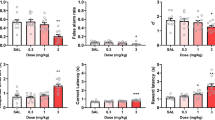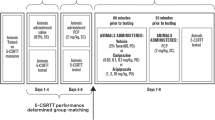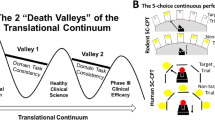Abstract
Rationale
CB1 receptors (CB1Rs) mediate many of the psychoactive effects of cannabinoids, and marijuana intoxication can produce neurocognitive deficits with a similarity to those seen in schizophrenia, including impairments of attention.
Objectives
We thus sought to characterize the effects of a CB1R-selective agonist and antagonist on attention in the rat using a lateralized reaction time task (LRT). We hypothesized that CB1R agonists would impair performance and that CB1R antagonists might improve performance.
Methods
Subjects were trained to perform the LRT, a procedure that measured their ability to attend to and detect brief visual target stimuli. After training, we tested the effects of the CB1R agonist WIN55,212-2 (WIN; 0–2.5 mg/kg) or the CB1R antagonist SR141716A (SR; 0–1.0 mg/kg), administered alone or in combination, on visual attention performance using task conditions in which target stimulus salience was varied systematically across trials.
Results
The highest dose of WIN reduced correct choices in well-trained rats, with impairment greatest at the shortest stimulus durations. The highest dose of WIN also increased omissions and slowed response times. By contrast, SR itself did not produce any measurable effects on performance but was able to prevent the impairment produced by WIN.
Conclusions
These results suggest that CB1Rs mediate the attentional performance impairments caused by acute administration of cannabinoid agonists and begin to unravel the possible contribution of cannabinoid systems to the pathophysiological substrates of cognitive dysfunction in schizophrenia.




Similar content being viewed by others
References
Abood ME, Martin BR (1992) Neurobiology of marijuana abuse. Trends Pharmacol Sci 13:201–206
Acquas E, Pisanu A, Marrocu P, Goldberg SR, Di Chiara G (2001) Delta9-tetrahydrocannabinol enhances cortical and hippocampal acetylcholine release in vivo: a microdialysis study. Eur J Pharmacol 419:155–161
Ameri A (1999) The effects of cannabinoids on the brain. Prog Neurobiol 58:315–348
Arseneault L, Cannon M, Poulton R, Murray R, Caspi A, Moffitt TE (2002) Cannabis use in adolescence and risk for adult psychosis: longitudinal prospective study. BMJ 325:1212–1213
Arseneault L, Cannon M, Witton J, Murray RM (2004) Causal association between cannabis and psychosis: examination of the evidence. Br J Psychiatry 184:110–117
Baunez C, Robbins TW (1999) Effects of dopamine depletion of the dorsal striatum and further interaction with subthalamic nucleus lesions in an attentional task in the rat. Neuroscience 92:1343–1356
Bersani G, Orlandi V, Kotzalidis GD, Pancheri P (2002) Cannabis and schizophrenia: impact on onset, course, psychopathology and outcomes. Eur Arch Psychiatry Clin Neurosci 252:86–92
Bizarro L, Stolerman IP (2003) Attentional effects of nicotine and amphetamine in rats at different levels of motivation. Psychopharmacology (Berl) 170:271–277
Brodkin J, Moerschbaecher JM (1997) SR141716A antagonizes the disruptive effects of cannabinoid ligands on learning in rats. J Pharmacol Exp Ther 282:1526–1532
Brown VJ, Bowman EM (2002) Rodent models of prefrontal cortical function. Trends Neurosci 25:340–343
Buchsbaum MS, Nuechterlein KH, Haier RJ, Wu J, Sicotte N, Hazlett E, Asarnow R, Potkin S, Guich S (1990) Glucose metabolic rate in normals and schizophrenics during the Continuous Performance Test assessed by positron emission tomography. Br J Psychiatry 156:216–227
Burk JA, Mair RG (2001) Effects of intralaminar thalamic lesions on sensory attention and motor intention in the rat: a comparison with lesions involving frontal cortex and hippocampus. Behav Brain Res 123:49–63
Carli M, Robbins TW, Evenden JL, Everitt BJ (1983) Effects of lesions to ascending noradrenergic neurones on performance of a 5-choice serial reaction task in rats; implications for theories of dorsal noradrenergic bundle function based on selective attention and arousal. Behav Brain Res 9:361–380
Carli M, Evenden JL, Robbins TW (1985) Depletion of unilateral striatal dopamine impairs initiation of contralateral actions and not sensory attention. Nature 313:679–682
Chaperon F, Thiebot MH (1999) Behavioral effects of cannabinoid agents in animals. Crit Rev Neurobiol 13:243–281
Christakou A, Robbins TW, Everitt BJ (2001) Functional disconnection of a prefrontal cortical-dorsal striatal system disrupts choice reaction time performance: implications for attentional function. Behav Neurosci 115:812–825
Coull JT, Frith CD, Dolan RJ, Frackowiak RS, Grasby PM (1997) The neural correlates of the noradrenergic modulation of human attention, arousal and learning. Eur J Neurosci 9:589–598
Di Marzo V, Melck D, Bisogno T, De Petrocellis L (1998) Endocannabinoids: endogenous cannabinoid receptor ligands with neuromodulatory action. Trends Neurosci 21:521–528
Dumas P, Saoud M, Bouafia S, Gutknecht C, Ecochard R, Dalery J, Rochet T, d’Amato T (2002) Cannabis use correlates with schizotypal personality traits in healthy students. Psychiatry Res 109:27–35
Fox A, Kesingland A, Gentry C, McNair K, Patel S, Urban L, James I (2001) The role of central and peripheral Cannabinoid1 receptors in the antihyperalgesic activity of cannabinoids in a model of neuropathic pain. Pain 92:91–100
Gifford AN, Ashby CR Jr (1996) Electrically evoked acetylcholine release from hippocampal slices is inhibited by the cannabinoid receptor agonist, WIN 55212-2, and is potentiated by the cannabinoid antagonist, SR 141716A. J Pharmacol Exp Ther 277:1431–1436
Gray JR, Chabris CF, Braver TS (2003) Neural mechanisms of general fluid intelligence. Nat Neurosci 6:316–322
Hampson RE, Deadwyler SA (2000) Cannabinoids reveal the necessity of hippocampal neural encoding for short-term memory in rats. J Neurosci 20:8932–8942
Han CJ, Pierre-Louis J, Scheff A, Robinson JK (2000) A performance-dependent adjustment of the retention interval in a delayed non-matching-to-position paradigm differentiates effects of amnestic drugs in rats. Eur J Pharmacol 403:87–93
Herkenham M, Lynn AB, Johnson MR, Melvin LS, de Costa BR, Rice KC (1991) Characterization and localization of cannabinoid receptors in rat brain: a quantitative in vitro autoradiographic study. J Neurosci 11:563–583
Hooker WD, Jones RT (1987) Increased susceptibility to memory intrusions and the Stroop interference effect during acute marijuana intoxication. Psychopharmacology (Berl) 91:20–24
Jentsch JD (2003) Genetic vasopressin deficiency facilitates performance of a lateralized reaction-time task: altered attention and motor processes. J Neurosci 23:1066–1071
Jentsch JD, Taylor JR (2003) Sex-related differences in spatial divided attention and motor impulsivity in rats. Behav Neurosci 117:76–83
Jentsch JD, Andrusiak E, Tran A, Bowers MB Jr, Roth RH (1997) Delta 9-tetrahydrocannabinol increases prefrontal cortical catecholaminergic utilization and impairs spatial working memory in the rat: blockade of dopaminergic effects with HA966. Neuropsychopharmacology 16:426–432
Johns A (2001) Psychiatric effects of cannabis. Br J Psychiatry 178:116–122
Leweke FM, Giuffrida A, Wurster U, Emrich HM, Piomelli D (1999a) Elevated endogenous cannabinoids in schizophrenia. Neuroreport 10:1665–1669
Leweke FM, Schneider U, Thies M, Munte TF, Emrich HM (1999b) Effects of synthetic delta9-tetrahydrocannabinol on binocular depth inversion of natural and artificial objects in man. Psychopharmacology (Berl) 142:230–235
Lichtman AH (2000) SR 141716A enhances spatial memory as assessed in a radial-arm maze task in rats. Eur J Pharmacol 404:175–179
Lichtman AH, Dimen KR, Martin BR (1995) Systemic or intrahippocampal cannabinoid administration impairs spatial memory in rats. Psychopharmacology (Berl) 119:282–290
Lichtman AH, Varvel SA, Martin BR (2002) Endocannabinoids in cognition and dependence. Prostaglandins Leukot Essent Fatty Acids 66:269–285
Macavoy MG, Marks DF (1975) Divided attention performance of cannabis users and non-users following cannabis and alcohol. Psychopharmacologia 44:147–152
Mallet PE, Beninger RJ (1998) The cannabinoid CB1 receptor antagonist SR141716A attenuates the memory impairment produced by delta9-tetrahydrocannabinol or anandamide. Psychopharmacology (Berl) 140:11–19
Marsicano G, Wotjak CT, Azad SC, Bisogno T, Rammes G, Cascio MG, Hermann H, Tang J, Hofmann C, Zieglgansberger W, Di Marzo V, Lutz B (2002) The endogenous cannabinoid system controls extinction of aversive memories. Nature 418:530–534
Mass R, Bardong C, Kindl K, Dahme B (2001) Relationship between cannabis use, schizotypal traits, and cognitive function in healthy subjects. Psychopathology 34:209–214
Matsuda LA, Bonner TI, Lolait SJ (1993) Localization of cannabinoid receptor mRNA in rat brain. J Comp Neurol 327:535–550
Muir JL, Everitt BJ, Robbins TW (1996) The cerebral cortex of the rat and visual attentional function: dissociable effects of mediofrontal, cingulate, anterior dorsolateral, and parietal cortex lesions on a five-choice serial reaction time task. Cereb Cortex 6:470–481
Nelson CL, Burk JA, Bruno JP, Sarter M (2002) Effects of acute and repeated systemic administration of ketamine on prefrontal acetylcholine release and sustained attention performance in rats. Psychopharmacology (Berl) 161:168–179
Onaivi ES, Leonard CM, Ishiguro H, Zhang PW, Lin Z, Akinshola BE, Uhl GR (2002) Endocannabinoids and cannabinoid receptor genetics. Prog Neurobiol 66:307–344
Oranje B, van Berckel BN, Kemner C, van Ree JM, Kahn RS, Verbaten MN (2000) The effects of a sub-anaesthetic dose of ketamine on human selective attention. Neuropsychopharmacology 22:293–302
Pan X, Ikeda SR, Lewis DL (1998) SR 141716A acts as an inverse agonist to increase neuronal voltage-dependent Ca2+currents by reversal of tonic CB1 cannabinoid receptor activity. Mol Pharmacol 54:1064–1072
Passetti F, Chudasama Y, Robbins TW (2002) The frontal cortex of the rat and visual attentional performance: dissociable functions of distinct medial prefrontal subregions. Cereb Cortex 12:1254–1268
Pistis M, Ferraro L, Pira L, Flore G, Tanganelli S, Gessa GL, Devoto P (2002) Delta(9)-tetrahydrocannabinol decreases extracellular GABA and increases extracellular glutamate and dopamine levels in the rat prefrontal cortex: an in vivo microdialysis study. Brain Res 948:155–158
Robbins TW (2002) The 5-choice serial reaction time task: behavioural pharmacology and functional neurochemistry. Psychopharmacology (Berl) 163:362–380
Robinson L, Hinder L, Pertwee RG, Riedel G (2003) Effects of delta9-THC and WIN-55,212-2 on place preference in the water maze in rats. Psychopharmacology (Berl) 166:40–50
Rogers RD, Baunez C, Everitt BJ, Robbins TW (2001) Lesions of the medial and lateral striatum in the rat produce differential deficits in attentional performance. Behav Neurosci 115:799–811
Schneider M, Koch M (2002) The cannabinoid agonist WIN 55,212-2 reduces sensorimotor gating and recognition memory in rats. Behav Pharmacol 13:29–37
Schneider U, Leweke FM, Mueller-Vahl KR, Emrich HM (1998) Cannabinoid/anandamide system and schizophrenia: is there evidence for association? Pharmacopsychiatry 31(Suppl 2):110–113
Solowij N, Stephens RS, Roffman RA, Babor T, Kadden R, Miller M, Christiansen K, McRee B, Vendetti J (2002) Cognitive functioning of long-term heavy cannabis users seeking treatment. JAMA 287:1123–1131
Terranova JP, Storme JJ, Lafon N, Perio A, Rinaldi-Carmona M, Le Fur G, Soubrie P (1996) Improvement of memory in rodents by the selective CB1 cannabinoid receptor antagonist, SR 141716. Psychopharmacology (Berl) 126:165–172
Tsou K, Brown S, Sanudo-Pena MC, Mackie K, Walker JM (1998) Immunohistochemical distribution of cannabinoid CB1 receptors in the rat central nervous system. Neuroscience 83:393–411
Tzavara ET, Wade M, Nomikos GG (2003) Biphasic effects of cannabinoids on acetylcholine release in the hippocampus: site and mechanism of action. J Neurosci 23:9374–9384
Varvel SA, Lichtman AH (2002) Evaluation of CB1 receptor knockout mice in the Morris water maze. J Pharmacol Exp Ther 301:915–924
Varvel SA, Hamm RJ, Martin BR, Lichtman AH (2001) Differential effects of delta 9-THC on spatial reference and working memory in mice. Psychopharmacology (Berl) 157:142–150
Veen ND, Selten JP, Van Der Tweel I, Feller WG, Hoek HW, Kahn RS (2004) Cannabis use and age at onset of schizophrenia. Am J Psychiatry 161:501–506
Verrico CD, Jentsch JD, Dazzi L, Roth RH (2003) Systemic, but not local, administration of cannabinoid CB1 receptor agonists modulate prefrontal cortical acetylcholine efflux in the rat. Synapse 48:178–183
Zammit S, Allebeck P, Andreasson S, Lundberg I, Lewis G (2002) Self reported cannabis use as a risk factor for schizophrenia in Swedish conscripts of 1969: historical cohort study. BMJ 325:1199
Author information
Authors and Affiliations
Corresponding author
Rights and permissions
About this article
Cite this article
Arguello, P.A., Jentsch, J.D. Cannabinoid CB1 receptor-mediated impairment of visuospatial attention in the rat. Psychopharmacology 177, 141–150 (2004). https://doi.org/10.1007/s00213-004-1953-0
Received:
Accepted:
Published:
Issue Date:
DOI: https://doi.org/10.1007/s00213-004-1953-0




